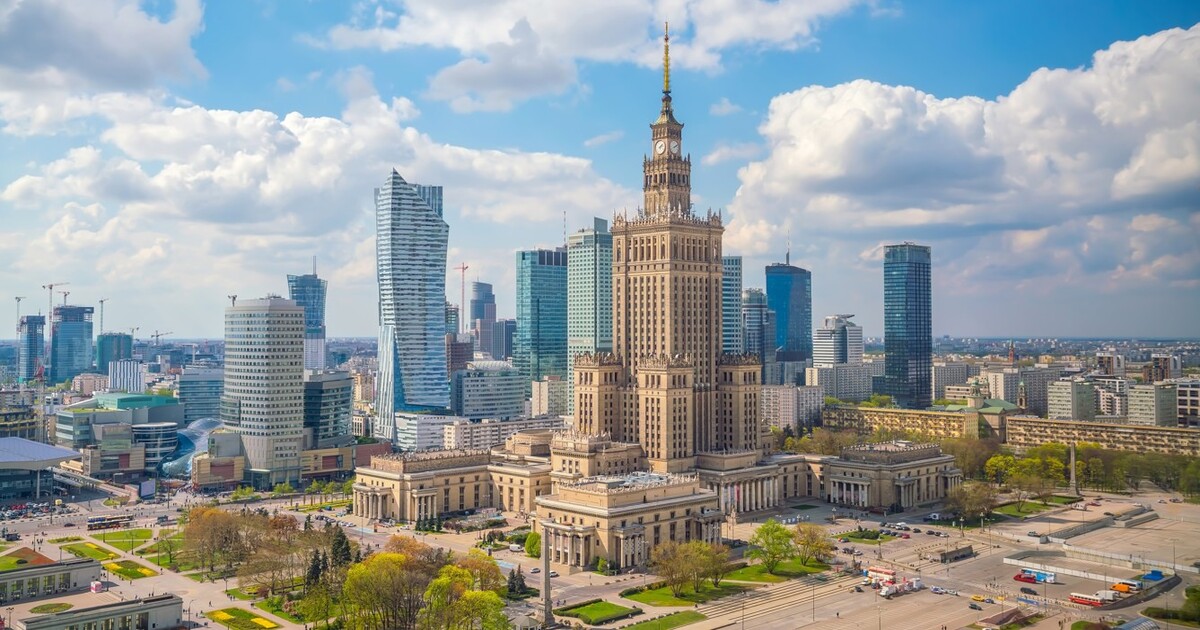Warsaw: A Role Model for Berlin
Poland’s success story is about way more than just strong economic growth.
October 3, 2025

A Strategic Assessment Memo (SAM) from the Global Ideas Center
You may quote from this text, provided you mention the name of the author and reference it as a new Strategic Assessment Memo (SAM) published by the Global Ideas Center in Berlin on The Globalist.
For many decades, Germany has looked west. But the hard turn in the United States under Donald Trump, with his radical “America first” philosophy, is seriously shattering the belief that that country could be a role model or even inspiration.
At the same time, Russia’s brutal war against Ukraine, Poland’s direct neighbor, underpins the notion that Europe’s political future, to a great part, will be decided in its Eastern regions.
One thing is for sure: The continent’s future is no longer forged solely in the Brussels-Berlin-Paris triangle.
Looking eastward for inspiration
The consequence of these twin developments is this: For a glimpse of economic vitality, technological innovation and political renewal, Western Europeans are well advised now to look east to the Baltics as well as to Poland.
Poland indeed increasingly emerged as a key player in Europe’s future. Over the past 30 years, it has succeeded in becoming the country with the highest economic growth in all of Europe. The results are visible everywhere: In a modernized infrastructure, a vibrant private business sector and in the wallets of Poles.
Warsaw’s urban success story
Take Warsaw. It was the most destroyed city in all of Europe at the end of the Second World War. Today, the city offers attractive architecture, a vivid city life and a clear lesson in urban progress — one its sister city, Berlin, could learn from a lot.
Berlin, for sure, is an amazing city. Millions of tourists have felt the vibe of this reunified city and its unique mixture of interesting history, old and new architecture, diversity and cultural richness.
Where Berlin struggles…
The German capital city grapples with ever more gridlock on many issues. They stem from a toxic mix of inefficient governance, insufficient public services for its citizens and a lack of clear vision of what Berlin wants to become.
No wonder that it has long become a popular sport for true Berliners to criticize everything around them. To cope with their justified levels of frustration, they often exhibit a very curious civic form of pride in things not working in Berlin. That’s some comic relief.
After all, it is not a lack of money why Berlin is on the verge of failing. Rather, it is due to a bizarre combination of inefficient bureaucracy with a low readiness in the public sector to get things quickly done.
… Warsaw succeeds
In sharp contrast, the Polish capital is demonstrating how transformation can succeed — it’s efficient, clean, safe and digitally advanced.
Poland’s Deputy Foreign Minister, Henryka Mościcka-Dendys, recently highlighted this at a Berlin event, and the statistics support her claims. A whopping 98% of Warsaw residents are satisfied with their city’s safety — a figure Berlin can only dream of.
Among the world’s safest
According to international rankings, Warsaw, a city of two million, is among the world’s safest. Friends from Utah, visiting Warsaw, were shocked when I invited them for a stroll through the city center at night.
They asked where we could walk safely and where the no-go areas are. It was difficult for them to believe that there isn’t such a thing in Warsaw.
Refugee management: A big contrast
Both Berlin and Warsaw have to cope with the massive inflow of refugees. But again, the contrast couldn’t be sharper. Warsaw absorbed hundreds of thousands of Ukrainian refugees following Russia’s second invasion in 2022.
In contrast, Berlin still runs so-called refugee centers — some of them more expansive than putting refugees in hotels, only that standards in the refugee centers are much below hotels.
Warsaw managed to do so without the need for large-scale shelters or social instability. Warsaw’s secret? Bold, swift and pragmatic action driven by smart planning and a shared sense of responsibility among the government, civil society and administration.
It is more than ironic that, once upon a time, those were also virtues displayed in German public sector management.
Focus on the management of public parks
Warsaw is also setting standards in urban development. Its parks and green spaces are meticulously maintained and expanded, and the city’s cleanliness is immediately obvious.
In Berlin, there is a lively and increasingly painful as well as embarrassing discussion about how littered public spaces are. Graffiti is everywhere (too bad: not created by Banksy).
Meanwhile, Warsaw is greening its urban landscape with initiatives like “One Million Trees for Warsaw,” to be taken literally: Each month you see new trees planted, and not small ones. Warsaw, thereby, turned from grey to green.
From Analog Berlin…
Berlin is often still stuck in analog bureaucracy, with clunky printers and fax machines. Citizens still need to wait weeks and months to even get a date for an administrative appointment in one of Berlin’s so-called “citizen offices”.
Last year, I tried to fix an appointment to get a new ID card. Within the two-month period you are given to book such an appointment, there wasn’t a single free spot.
…to Digital Warsaw
Warsaw, for its part, has resolutely embraced the digital age. Its citizens can complete almost all administrative tasks online, efficiently and without hassle. A centralized ID number (“Pesel”) streamlines processes and boosts digital innovation.
From getting your car registered and obtaining residential parking permits, paying taxes to getting your last vaccination documented: all is easily done online.
The contrast is stark: Warsaw offers digital efficiency and user-focused services, while German bureaucracy is still defined by paper trails and long in-person waiting lines.
It remains to be seen whether Germany’s newly created Federal Ministry for Digital Transformation will make a visible difference or just be another layer of “bureaucrazy.”
Warsaw’s approach to refugee education is also a standout
While Germany debates the feasibility of integration, Warsaw is proving it’s possible. Ukrainian refugee children are quickly enrolled in schools, and their teachers are integrated and recognized.
In Germany, Ukrainian teachers (almost all female) fight with getting their academic credentials accepted and are asked to first learn German at a high proficiency level.
In the meantime, since 2015 25,000 refugee children have entered schools in Berlin, among them the vast majority Ukrainian children who would love to be taught math or history in their mother tongue. Again, Poland is a powerful example of a country that actively tackles challenges instead of just complaining about them.
Warsaw’s transit system is another model for Berlin
In Berlin, transportation projects are bogged down by years of planning and delays, which often involve failed attempts to structure public bidding processes in a legally correct fashion, lawsuits and eternally contested court decisions.
Meanwhile, Warsaw is building. You could say that the Polish capital city is proceeding with the sense of initiative and dynamism that was the hallmark of Berlin city management during the “founding years” in the decades before and after the turn of the 19th to the 20th century.
And from which the German capital, with its teetering public infrastructure, still benefits to the day.
New subway lines are built in Warsaw in record time, steadily complementing a dense network of trams, electric buses and bike lanes. The public transit system is on time, clean and deemed a core part of the city’s quality of life.
Never mind that the equipment is also air-conditioned, whereas Berlin fights climate change in summers with open windows in overheated metro trains, even the newly bought ones.
A new European reality
Warsaw demonstrates that complex challenges can be overcome with bold action, simplified processes and a focus on people.
The willingness to change for a better future. This is a mindset from which Germany could profit because change is still too often viewed as a threat, not an opportunity.
Ironically, fighting ideological battles or clinging to the past over public projects and priorities, long considered an “Eastern” trait, is what distinguishes 21st century Berlin. Getting back to its own dynamic roots, this is the lesson to be learned.
Conclusion
To move forward, Germany needs to break free from defending the status quo. It is high time to look beyond its traditional Western partners and recognize the strategic, cultural and economic importance of Eastern Europe — Poland is not alone. Just think of the dynamic Baltic Republics.
That region is not merely a “new market” or a geopolitical backyard. It is the heart of a new European identity. Today’s Poland is its driving force.
Adopting to this expanded, if not profoundly altered field of vision and inspiration requires a new mindset in Germany – one of broadening horizons, cultivating new partnerships and learning from one another with mutual respect and openness.
There is hope: Friedrich Merz, Germany’s new chancellor, on his first trip after having been elected last April, visited Paris and Warsaw on the same day to underpin that he understands the growing role Poland plays in Europe.
Editor’s Note: This article was inspired by a recent panel discussion hosted by the VBKI (Berlin Merchants and Industrialists’ Association) on Poland’s development, featuring Johannes von Thadden and Deputy Foreign Minister Henryka Mościcka-Dendys.
The discussion was moderated by Kirsten Giering. More information is available at www.vbki.de/dialog. A version of this article first appeared in “Der Tagesspiegel” on September 4, 2025, co-authored by Kirsten Giering, founder of Sinica Consulting and co-chair of the VBKI’s Committee for International Politics and Economy.
Takeaways
For a glimpse of economic vitality, technological innovation and political renewal, Western Europeans are well advised now to look east to the Baltics as well as to Poland.
Warsaw offers attractive architecture, a vivid city life and a clear lesson in urban progress — one its sister city, Berlin, could learn from a lot.
The German capital city grapples with ever more gridlock on many issues. They stem from a toxic mix of inefficient governance, insufficient public services for its citizens and a lack of clear vision of what Berlin wants to become.
A whopping 98% of Warsaw residents are satisfied with their city’s safety — a figure Berlin can only dream of.
Warsaw is greening its urban landscape with initiatives like "One Million Trees for Warsaw," to be taken literally: Each month you see new trees planted, and not small ones. Warsaw, thereby, turned from grey to green.
Warsaw offers digital efficiency and user-focused services, while German bureaucracy is still defined by paper trails and long in-person waiting lines.
The Polish capital city is proceeding with the sense of initiative and dynamism that was the hallmark of Berlin city management during the “founding years” in the decades before and after the turn of the 19th to the 20th century.
Warsaw demonstrates that complex challenges can be overcome with bold action, simplified processes and a focus on people.
Fighting ideological battles or clinging to the past over public projects and priorities, long considered an “Eastern” trait, is what distinguishes 21st century Berlin. Getting back to its own dynamic roots, this is the lesson to be learned.
To move forward, Germany needs to break free from defending the status quo. It is high time to look beyond its traditional Western partners and recognize the strategic, cultural and economic importance of Eastern Europe — Poland is not alone. Just think of the dynamic Baltic Republics.
A Strategic Assessment Memo (SAM) from the Global Ideas Center
You may quote from this text, provided you mention the name of the author and reference it as a new Strategic Assessment Memo (SAM) published by the Global Ideas Center in Berlin on The Globalist.


